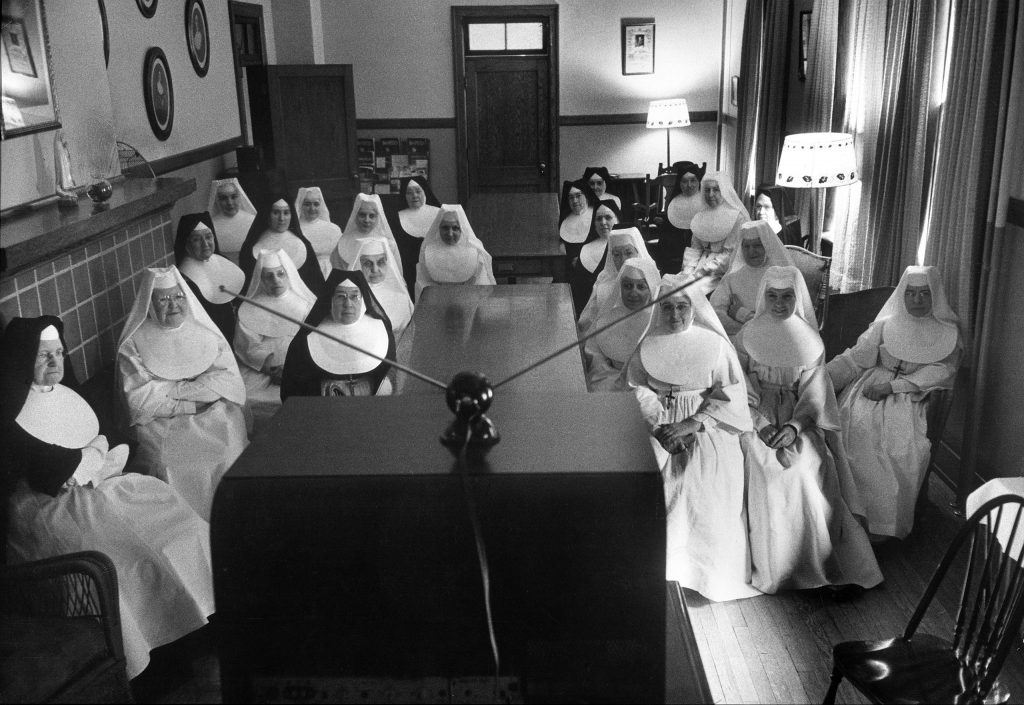Monumental events, mindless comedy, sports victories, talk shows, filibusters and on and on: television has shown it all. Almost any TV show will find an audience and some will find millions. Long before the recent dawn of cord-cutting and personal screens, when TV was in its infancy and then rising as a black-and-white cultural mainstay, it sometimes served as a venue for group gatherings. A shared activity, even if that activity was (usually) pretty passive.
Here LIFE looked back at some Americans, famous and not, who liked to watch.
Liz Ronk edited this gallery for LIFE.com. Follow her on Twitter @lizabethronk.

Radio Corporation of America (RCA) executives watched a brand new invention called television at their New York offices before introducing the product to the public, 1939.
Carl Mydans The LIFE Picture Collection/Shutterstock

Russell Finch, a writer, enjoyed the latest invention of the day, a portable television, while taking a bath, 1948.
George Skadding The LIFE Picture Collection/Shutterstock

Men gathered to watch TV through a store window in Pennsylvania in 1948.
Ralph Morse The LIFE Picture Collection/Shutterstock

A boy watched TV in an appliance store window in 1948.
Ralph Morse The LIFE Picture Collection/Shutterstock

Sisters at St. Vincent’s Hospital in Erie, Penn., watched a program on a new local TV station, 1949.
Ralph Morse The LIFE Picture Collection/Shutterstock

Watching a Western, 1950
Alfred Eisenstaedt The LIFE Picture Collection/Shutterstock

A group of swimmers at an indoor pool watched the Russian ambassador to the United Nations, Jacob Malik, filibustering in the UN Security Council in 1950.
George Skadding The LIFE Picture Collection/Shutterstock

Grade school kids in Minneapolis watched a video “classroom lesson” on TV while the city’s public schools were on strike in 1951.
Francis Miller The LIFE Picture Collection/Shutterstock

A rapt audience in a Chicago bar watched the 1952 World Series between the Dodgers and Yankees. (The Yankees won.)
Francis Miller The LIFE Picture Collection/Shutterstock

Six-year-old girls used a “Winky Dink” drawing kit on their home TV screen as they watch the kids’ program, Winky Dink and You, 1953. The show, which aired for four years in the 1950s, has been cited as “the first interactive TV show,” especially in light of its “magic drawing screen” a piece of plastic that stuck to the TV screen, and on which viewers could trace the action on the screen.
Walter Sanders The LIFE Picture Collection/Shutterstock

A performing chimpanzee named Zippy watched TV in 1955.
Michael Rougier The LIFE Picture Collection/Shutterstock

An adopted Korean war orphan, Kang Koo Ri, watched television in his new home in Los Angeles in 1956.
Allan Grant The LIFE Picture Collection/Shutterstock

Milwaukee fans watched the 1957 World Series, when their Braves beat the Yankees in seven games.
Francis Miller The LIFE Picture Collection/Shutterstock

A railroad worker’s family watched TV in a trailer at a camp for Southern Pacific employees in Utah in 1957.
Frank Scherschel The LIFE Picture Collection/Shutterstock

An awe-struck baseball watched the Braves win the World Series in Milwaukee in 1957.
Francis Miller The LIFE Picture Collection/Shutterstock

A traveling businessman watched TV in a hotel room in 1958.
Nat Farbman The LIFE Picture Collection/Shutterstock

Tenant farmer Thomas B. Knox and his family watched Ed Sullivan and ventriloquist Rickie Layne on The Ed Sullivan Show in 1958.
Ed Clark The LIFE Picture Collection/Shutterstock

Picketing workers watched TV in a tent outside the gates of a U.S. Steel plant in Gary, Indiana, during a strike in 1959.
Francis Miller The LIFE Picture Collection/Shutterstock

Vice President Richard Nixon and his wife, Pat, watched the 1960 GOP convention in Chicago from their hotel suite.
Hank Walker The LIFE Picture Collection/Shutterstock

The Kim Sisters—a Korean-born singing trio who had some success in the U.S. in the 1960s —watched television in Chicago in 1960.
Robert W. Kelley The LIFE Picture Collection/Shutterstock

Eventual VP candidate Lyndon Johnson watched TV during the 1960 Democratic National Convention in Los Angeles.
Thomas D. McAvoy The LIFE Picture Collection/Shutterstock

A “Three-Eyed TV Monster” created by Ulises Sanabria permitted simultaneous two- and three-screen viewing, 1961.
Francis Miller The LIFE Picture Collection/Shutterstock

Astronaut Scott Carpenter’s wife, Rene, and son, Marc, watched his 1962 orbital flight on TV. Carpenter’s was NASA’s second manned orbital flight, after John Glenn’s, and lasted nearly five hours.
Ralph Morse The LIFE Picture Collection/Shutterstock

Die-hard New York Giants fans watched the 1962 NFL championship game against the Packers outside a Connecticut motel, beyond the range of the NYC-area TV blackout, December 1962. Green Bay won, 16-7.
John Loengard The LIFE Picture Collection/Shutterstock

A crowd watched John F. Kennedy address the nation during the Cuban Missile Crisis, October 1962.
Ralph Crane The LIFE Picture Collection/Shutterstock

Frank Sinatra watched his son, Frank Jr., 21, emcee a TV show, 1964.
John Dominis The LIFE Picture Collection/Shutterstock

Different CATV (Community Antenna Television) stations available to subscribers in Elmira, New York, in 1966.
Arthur Schatz The LIFE Picture Collection/Shutterstock

Actress Diahann Carroll and journalist David Frost watched themselves on separate talk shows. Carroll and Frost were engaged for a while, but never married.
Bill Ray The LIFE Picture Collection/Shutterstock


















































































































